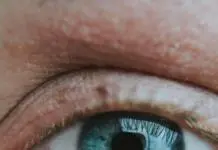Lazy eye is a vision development disorder. In this, an eye fails to reach normal visual acuity, even with the help of eyeglasses or contact lenses.
Amblyopia is also known as lazy eye, typically begins through early childhood. In most case, amblyopia only occur in one eye but in some cases it occur in both eyes.
If it is detected at the beginning and treated well, reduced vision can be avoided. However, the affected lazy eye can make constant loss of vision if not treated.
Signs And Symptoms

As lazy eye or amblyopia is a vision development disorder found in infant, that is why it’s symptoms can be sometime difficult to spot.
Strabismus is a common cause of amblyopia.
If your infant has crossed eyes then immediately visit or schedule an appointment with an ophthalmologist and protect your child from amblyopia.
If your child cries when you cover their one eye, then it is a symptom of lazy eyes.
When one eye of your child is covered and they do not feel uncomfortable, however objects when the other eye is, this may consider that the covered eye is not a lazy eye and uncovered eye is considered as lazy eye.
Causes of Lazy Eye
There are three types of lazy eye, which are as follows:
Strabismic Amblyopia

It is the most common cause of lazy eye. In order to avoid double vision caused by poorly aligned eyes, the brain will not pay attention to the visual input from the unaligned eye, create amblyopia in that eye.
Refractive Amblyopia

A lazy eye is caused by different refractive errors in both eyes, inspite perfect eye alignment. For instance, from both eyes, only one eye may have significant nearsightedness or farsightedness. Or only one eye may have significant astigmatism and the other eye does not. In these cases, the brain depend on the eye that has less uncorrected refractive error and “tunes out” the blurred vision from the other eye, causing amblyopia in that eye from disuse.
Deprivation Amblyopia

This is lazy eye caused by something that block light from entering and being focused in an infant eye, like congenital cataract. Cataract surgery is important for the congential cataract to allow normal visual development to occur and stop a visual disability from lazy eye.
How To Fix A Lazy Eye
In few cases of refractive amblyopia, normal vision can be attain simply by fully correcting the refractive errors in both eyes with contact lenses or eye glasses. But, some patching of the perfect eye is required to force the brain to pay attention to the visual input from the “lazy” eye and permit normal vision development to occur in that eye.
A good option for the treatment of strabismic amblyopia is Strabismus surgery to align the eyes, followed by use of an eye patch on the presiding eye and some form of vision therapy to help eyes work together as a team.

It may be important to wear an eye patch for many hours each day because it force the brain to start using the lazy eye normally.
If your child not wearing eye patch, you might consider a specially designed prosthetic contact lens that stop light from entering the good eye however does not affect your child’s look.

Atropine eye drops can also be used to treat a lazy eye. Single drop is placed in your child’s good eye each day. It helps to blurs the close-up vision in the good eye, which forces your child to use the “lazy” eye. These drops does not require constant observation as compare to eye patch.
Some side effects of atropine include light sensitivity and difficulty seeing near objects clearly during the treatment.
Read more articles related to eye problem on lustereyes.


